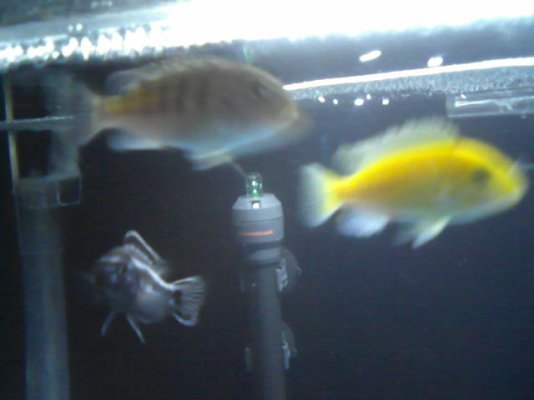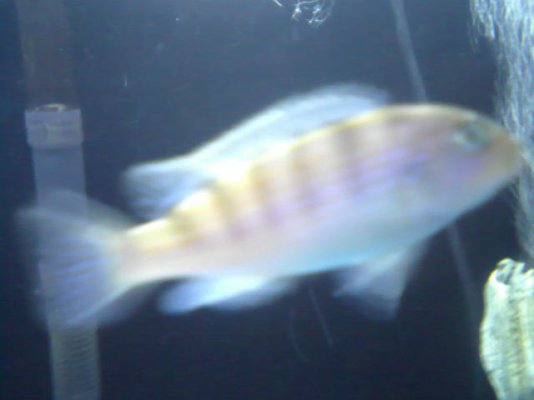I bought these (the yellow and white striped one) as an assorted african cichlid. I know the pics are a little blurry but the best I could get with my phone cam since they wont stay still for more than a second. Any idea what they may be? I was thinking maybe Kenyi
You are using an out of date browser. It may not display this or other websites correctly.
You should upgrade or use an alternative browser.
You should upgrade or use an alternative browser.
Help ID my Cichlid
- Thread starter onyx
- Start date
The friendliest place on the web for anyone with an interest in aquariums or fish keeping!
If you have answers, please help by responding to the unanswered posts.
If you have answers, please help by responding to the unanswered posts.
mattrox
Aquarium Advice Addict
It could be a kenyi, but many fish from mixed tanks are hybrids. The blue one looks like a kenyi, yellow kinda looks like a electric yellow hybrid.
I have two just like it. Here is the description. Hope it helps.
*Other common names: Electric yellow lab, Lemon Yellow, Yellow
*Size: up to 5 inches (13 cm.) females are usually much smaller then the males
*Scientific Name: Labidochromis Caeruleus Family- Cichlidae (Pseudocrenilabrinae)
*Natural Habitat: Rock dwelling Cichlid found in Lake Malawi (Africa)
*Description: Bright yellow in color, males have a black markings on their dorsal, pelvic and abdominal fins. Females have them only on the dorsal fins; however, some do have charcoal markings on the pelvic and abdominal fins. Also the males do have 1 or more egg spots on their anal fins, which the females completely lack.
*Recommended Tank Size and Temperament: 55 gallons is the recommended minimum size of any mbuna fish. (Because of their calm demeanor, they can be kept in a 30 gallon already, 1 male to 3-4 females ratio). They are rather calm for a Cichlid, and can be housed with a variety of species because of this.
Also lots of rocks are enjoyed by them for hiding as well as crashed coral substrate, which will help to keep the pH in the higher range without using any chemicals.
They can also be kept with dither fish, like giant danios, short finned serpae tetras… and with bristle nose plecos for bottom feeders.
*Water Parameters: pH 7.2-8.4, typically 8.0 is good. Temperature: 76-82°F. Harder water is preferred, so a GH of over 200 ppm is advised.
*Typical food: This fish is an omnivore. A quality flake such as Spirulina 20 or pellet (or Cichlid Stick) is a good for this fish. This can be supplemented with frozen foods as a treat.
*Breeding: Maternal mouth brooder, substrate spawner. Typical incubation time is 28 days.
*Other common names: Electric yellow lab, Lemon Yellow, Yellow
*Size: up to 5 inches (13 cm.) females are usually much smaller then the males
*Scientific Name: Labidochromis Caeruleus Family- Cichlidae (Pseudocrenilabrinae)
*Natural Habitat: Rock dwelling Cichlid found in Lake Malawi (Africa)
*Description: Bright yellow in color, males have a black markings on their dorsal, pelvic and abdominal fins. Females have them only on the dorsal fins; however, some do have charcoal markings on the pelvic and abdominal fins. Also the males do have 1 or more egg spots on their anal fins, which the females completely lack.
*Recommended Tank Size and Temperament: 55 gallons is the recommended minimum size of any mbuna fish. (Because of their calm demeanor, they can be kept in a 30 gallon already, 1 male to 3-4 females ratio). They are rather calm for a Cichlid, and can be housed with a variety of species because of this.
Also lots of rocks are enjoyed by them for hiding as well as crashed coral substrate, which will help to keep the pH in the higher range without using any chemicals.
They can also be kept with dither fish, like giant danios, short finned serpae tetras… and with bristle nose plecos for bottom feeders.
*Water Parameters: pH 7.2-8.4, typically 8.0 is good. Temperature: 76-82°F. Harder water is preferred, so a GH of over 200 ppm is advised.
*Typical food: This fish is an omnivore. A quality flake such as Spirulina 20 or pellet (or Cichlid Stick) is a good for this fish. This can be supplemented with frozen foods as a treat.
*Breeding: Maternal mouth brooder, substrate spawner. Typical incubation time is 28 days.
You mean the dark blue one in the background? Yeah that's a blue johanniDo you have an id on the one next to it.
You mean the dark blue one in the background? Yeah that's a blue johanni
No the brown tan one.
Oh, it was in the same tank as the yellow one at the lfs with the same ID. Assorted AfricanNo the brown tan one.
Similar threads
- Replies
- 1
- Views
- 667
- Replies
- 5
- Views
- 857


